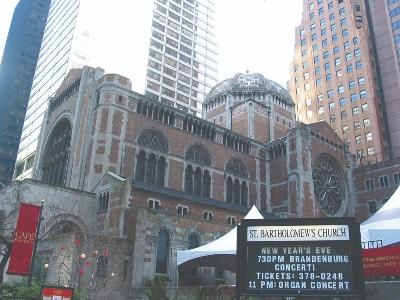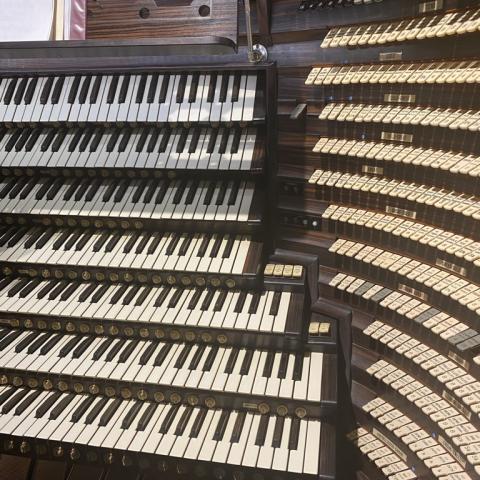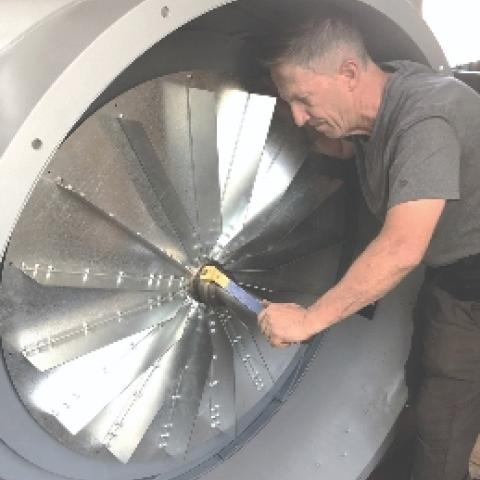
The Organ Clearing House goes to the movies.
In July 2010 Sony Pictures released Salt, a film directed by Phillip Noyce, starring Angelina Jolie and Liev
Schreiber. Ms. Jolie’s character is Evelyn Salt, a CIA agent accused of being a Soviet spy. Salt sets out to prove her innocence, and lots of people get hurt. One of the pivotal moments is the funeral of the American vice president held at Saint Bartholomew’s Church on Park Avenue in New York City. The church’s organist and choirmaster at the time, William Trafka, and the Saint Bartholomew’s Choir would perform a bit of Gabriel Fauré’s Requiem in D Minor as the vice president’s dear friend, President Matveyev of the Soviet Union, ascended the pulpit to deliver the eulogy. Salt would enter the church’s crypt from an adjacent subway tunnel, sabotage the organ’s wind and electrical systems creating a roaring disturbance, then detonate explosives that would deliver the pulpit, president and all, to the crypt where she would shoot him. Just another day in the life of a church.
Leslie Rollins, the film’s set decorator, read an article in The New York Times about the restoration by Quimby Pipe Organs of the organ at the Cathedral of Saint John the Divine, and the Quimby people recommended the Organ Clearing House to decorate the set of the basement mechanical room for the St. Bart’s organ. Leslie invited me to the film’s offices in New York’s Chelsea neighborhood where he led me into the world of make-believe-turned-believable, which is the motion picture industry. The office walls were festooned with concept drawings of the dozens of sets that would be built, and he led me through the story so I could understand the role of the set we would create.
I described the behind-the-scenes functions of a large pipe organ including the blower and adjacent static reservoir and an array of electro-pneumatic-mechanical switching equipment. Since this would be an active operating set, I arranged to take Leslie and a couple people from Special Effects (SFX) to visit a nearby church to see that kind of equipment in operation. As is usual when the blower was turned on, the static reservoir expanded about six inches. They were disappointed—it wasn’t dramatic enough. I told them that while I did not want to build anything that would not be credible to another organ builder, I agreed that we could fashion a mock-up regulator with a more dramatic range of motion.
We provided a large blower from our stock and a huge array of organ electrical equipment borrowed from the yet-to-be-restored W. W. Kimball Co. organ at Boardwalk Hall in Atlantic City, New Jersey (in return for a nice contribution to the restoration of that organ), and I built a hilarious double-rise reservoir using two-by-fours for top, bottom, and middle frames and ten-inch-wide ribs cut from plywood. I made the usual canvas hinges all around but only put leather on the three sides that would be exposed to the camera. Rather than the measly six-inch rise of a normal organ reservoir, this thing opened close to thirty inches.
The dozens of sets were built in a complex of unused aviation hangars in Bethpage, Long Island, previously owned by Grumman Aerospace Corporation, the site where the Lunar Excursion Module (LEM) that landed astronauts on the moon was built. The crypt had ribbed arched ceilings, much fancier than the actual basement at Saint Bartholomew’s, made of two-by-four frames and Styrofoam painted to simulate stone masonry.1
In April 2009 my colleague Amory Atkins and I gathered the blower and wind-system components along with metal windlines and regulating valves. I drove a truck to Atlantic City to collect the switching machines, and we met in Bethpage to assemble the fabrication. Once the big pieces were in place, we were joined by SFX who added the equipment that would animate the scene. Evelyn Salt would jump off a moving subway train, vault through an opening into the crypt, shoot the chain for the regulating valve causing the reservoir to rise dramatically, and shoot the switch stack causing a noisy explosion (way more sparks and smoke than a usual 12-volt DC organ system could produce). The organ above would roar into a mass cipher, the congregation would panic, Salt would scatter explosives under the foundation of the pulpit, and Bob’s your uncle. The set decorating team included a young hippie woman who floated a cart of art supplies about the place followed by a big floppy golden retriever. It was her job to make things look old. I gave her photos of a “real” organ blower room with the usual accumulation of dirt, dust, spider webs, and debris, and she worked her magic to make it look authentic.
I showed Leslie the completed set and described what Ms. Jolie would have to do to put all that in motion. Bewildered, he asked me to come back in a couple weeks for the filming of the scene so I could explain it in person. When I arrived, I learned that they were running behind and did not know exactly when I would be needed. Could I stay around and be ready at a moment’s notice? For two days I watched the various actors take and retake their scenes, building the movie a few seconds at a time. Phillip Noyce moved from set to set with an entourage of aides with clipboards and flunkies who carried his chair and computer monitors around. I watched Angelina Jolie vault through that opening into the crypt dozens of times—she was doing her own stunts. Then came an urgent message over the public address system, “Organ guy to the crypt, organ guy to the crypt.”
Angelina Jolie came into my little sanctum with hand outstretched, “Hi, I’m Angie.” I explained the set-up, “You shoot this chain;” “I can’t shoot that;” “I’ve seen you shoot.” Mr. Noyce invited me to sit with him to watch the take onto his monitor. “When I point at you, you yell ‘action’!” (My big moment.) Leap, shoot, whoosh, shoot, flash, blam, roar. Noyce hollered, “Fantastic, cause and effect in one shoot.” And that was it. Angie jumped out that tunnel at least thirty times, but she shot my chain in one try.2
With the shoot complete, we broke down the set and returned all the gear. I was on the job for about three weeks. I saw the setup outdoors that would catapult a car off a highway bridge. I witnessed actors who were playing small roles asking Angie for autographs. I saw Angie and Brad Pitt coming and going from her trailer. I learned that 150 carpenters were employed for that one film. And when I saw the completed film, I was struck by how much effort went into building and decorating that set for a scene that lasted just a few seconds. If you watch the movie, do not take your eyes off the screen once you see Salt on a subway, or you will miss it. I was disappointed to learn that you had to be a $100,000 vendor to make the credits. I mentioned that I could have charged that, but it was too late.3
It is easy to stream Salt. I watched it a couple nights ago on Netflix. I saw the completed sets for the barge, the tunnel, the CIA stairway, the office where Salt made a bazooka from an office chair, the hotel room, the Bolt bus, and the North Korean prison.
I happened to ride past Saint Bartholomew’s in a taxi during the filming of the big explosion scene. There were dozens of fire trucks, police cruisers, and ambulances hovering about, and a crowd of extras big enough to create a church-filling congregation of mourners. I am sure the Fire Department of New York was a $100,000 vendor. They must have made the credits.
Let’s take it live.
My friend Angie got dozens of tries to make the perfect leap from the subway tunnel to the crypt of the church. Actors in live theater get one. They may have twenty or thirty performances, more if they are in a well-funded big-city show, but each night they get one chance for each moment of magic.
The other night, Wendy and I saw a production of Cabaret at the Barrington Stage Company in Pittsfield, Massachusetts. The venerable show has a cast of twenty-one, ten of whom are in the chorus known as the Kit Kat Ensemble—the Kit Kat Club is the main set for the show. The story is set in the jumbled unraveling of the cultural life of Berlin in the years leading up to Nazi domination and the start of World War II, where the Kit Kat Club is a refuge for a large part of the population we know today as LGBTQIA2S+, in a time when such self-identification was not understood or accepted by those outside the acronym. The atmosphere in the Kit Kat Club was of forced hilarity, longing, and sexual confusion.
The superb ten-piece orchestra was sitting on a tiered bandstand on stage, just as you would expect a band to be played in a dance club—think of Ricky Riccardo’s band on I Love Lucy—and the energetic dancing swirled around them. Sometimes a lead character would leap into the band to hide, lights out, as the scene was changed. Sometimes a member of the band was soloed-out, spotlight and all. And during the song “Tomorrow Belongs to Me” at the end of the first act, the lead keyboard player, who was also the conductor, scooped up a gleaming white accordion and led the ensemble to the front of the stage singing her heart out.
Cliff Bradshaw, the traveling, struggling American novelist, hopes to build a life with Sally, the club’s marquee singer. Herr Schulz, the neighboring fruit vendor, dreams of marrying Fräulein Schneider, the spinster landlady who rents rooms to the various women of the ensemble and tries to turn a blind eye to the parade of sailors coming and going in her house. Then Cliff realizes that he has been used as a courier for the Nazis. Herr Schulz is revealed as a Jew and Fräulein Schneider realizes that she cannot risk her scant living and safety by marrying him. Some characters deny the situation, some try to exploit it, and some are propelled by the frenzy of alcohol, drugs, and sexual freedom to the exclusion of everything else. The emcee is the heart of the show, inciting and weaving the intrigue, hinting at the macabre, reveling in the confusion, and has the longest list of dance steps, acrobatics, complex songs and monologues, costume changes, and sinister gestures of all the characters.
We were attending one of the last performances of the three-week run. As we arrived at the theater, we read that the curtain would be delayed. Sometime around the scheduled curtain time, it was announced that the actor playing the emcee was unable to appear, and the understudy was hard at work with the cast doing a last-minute blocking rehearsal on stage. A half hour later we entered the theater. “Willkommen,” the bawdy opening number, blasted onto the stage, and for two-and-a-half hours we watched, yelled, and whistled in awe as the understudy and heretofore chorus member James Rose (she/they), tall and slender with past-shoulder-length hair, brought the emcee to life in their first and last-minute crack at the role.
I am sure that Wendy and I have seen understudies taking on a role before, perhaps sometimes at the last minute, but not a role as complex as this. I doubt that this performance will go fuzzy in my memory but will join the file in my memory titled “Unforgettable.” The emcee is central to most of the songs and dances, and Rose’s interpretation included endless sinister, sensual, sensuous motions of their extra-long, extra-flexible fingers. I have no idea how much rehearsal time she had with that role, but she certainly spent a lot of time thinking and preparing for it. I would love to have been a fly on the wall for that last-minute rehearsal while we were waiting outside for the house to open; it must have been a very dramatic hour.
Art of the moment
In last month’s issue of The Diapason, I wrote about our recent trip to Athens, Florence, and Bologna during which we visited as many museums as our stamina would allow—more, in fact. We reveled in the timeless works by Giotto, Michelangelo, Caravaggio, and Ghiberti, as art lovers have for 500 or 600 years. If we are still able, we could go back and see them again in twenty years. You lean in to look at brush strokes, chisel marks, dappled sunlight, and facial expressions. Favorite souvenirs from the trip are the two-inch pieces of Carrara marble that I picked up from the roadway when we visited the quarry that was the source of stone for the sculptures of Michelangelo along with many other artists. What makes those stones magical are the hundreds of tiny, shiny facets that sparkle when I turn them under my desk lamp, the quality that breathes life into those monumental statues.
The performing arts are different. A piano sonata, an aria, a symphony, a Broadway show, or a hymn happens in real time. If the artist misses a piston or flubs a note, or a couple dancers run into each other, the moment vanishes but stays in memory. Cooperative music-making is one of the high points of the human condition. A symphony orchestra is a spectacular achievement, a choir is equally special, especially considering that it is just human voices. An opera or the musical we saw the other night is multi-dimensional, including singing, dancing, instrumental music, and live drama, and that production is a real romp—there is something happening onstage every second.
This notice was included as an insert in the playbill for Cabaret:
Barrington Stage wants to remind you that this is live theater; and for some of us, it can be church. Just like in church, you are welcome to come as you are—to hoot and holler or to sit quietly in reverence. Worship and engage however you feel most comfortable. Laugh audibly and have natural emotional and sometimes vocalized responses if you feel it. Just remember that while it’s okay to engage, we should aim to neither distract nor thwart the performance.
I know I hooted a few times, and probably hollered, too.
§
On November 14, 1943, the twenty-five-year-old Leonard Bernstein stood in for the ailing Bruno Walter at the last minute, conducting the New York Philharmonic Orchestra at Carnegie Hall, and his career took off like a rocket. James Rose’s performance the other night was other-worldly, and more breathtaking as she was a last-minute fill in. I wonder what was going through their mind during that curtain-delaying rehearsal. During the ovation at the end of the performance, fellow cast members were expressing their admiration, offering quiet, affectionate congratulations, and deferring to Rose for extra solo bows. It was a thrilling performance of a chilling character. The arts matter.
Nota bene
While I took hundreds of photos while working on Salt that show the various sets under construction, we were required to sign a non-disclosure agreement that barred us from publishing photographs taken on the set, and expressly forbidden from photographing the actors. Even though it was almost fifteen years ago, and though I would love to share some photos here, I will stick to the agreement I signed.
Notes
1. A different set for the film used another neat “faux-trick.” Late in the film, there is a scene where the American president is hustled down an elevator to a secure emergency facility deep underneath the White House. The tunnel between the elevator and the facility was ribbed, the ribs were made of swimming-pool noodles covered with thick spray paint.
2. Burt Dalton, foreman of SFX crew, won an Oscar for his work on The Curious Case of Benjamin Buttons the year before. I was impressed by his status on the set. When he walked by, people whispered in awe and respect.
3. Follow this link to see listing of cast and crew for Salt: https://www.imdb.com/title/tt0944835/fullcredits/?ref_=tt_cl_sm. There are over 180 cast members from Angelina Jolie as Salt to Zoë D’Amato, mourner. Scroll past the cast to see the crew, which included twenty-three makeup technicians and hundreds of others in the art department, sound department, special effects, visual effects, stunts, costumes, editorial, location, etc. It takes hundreds of people to make a movie like this.







